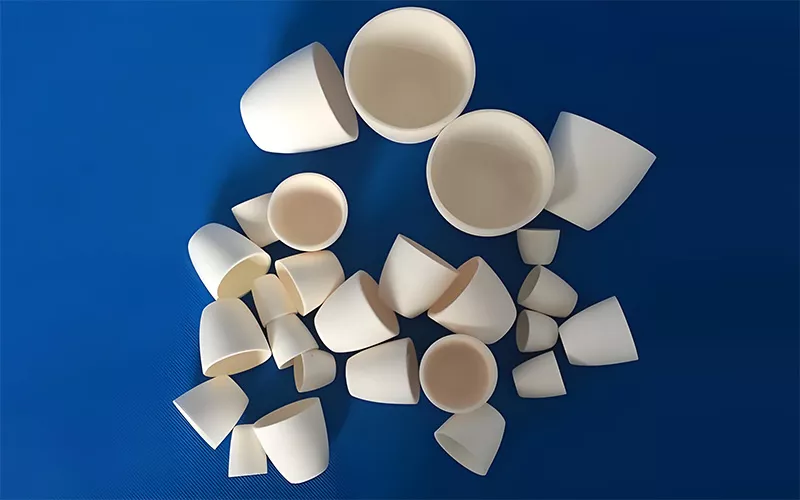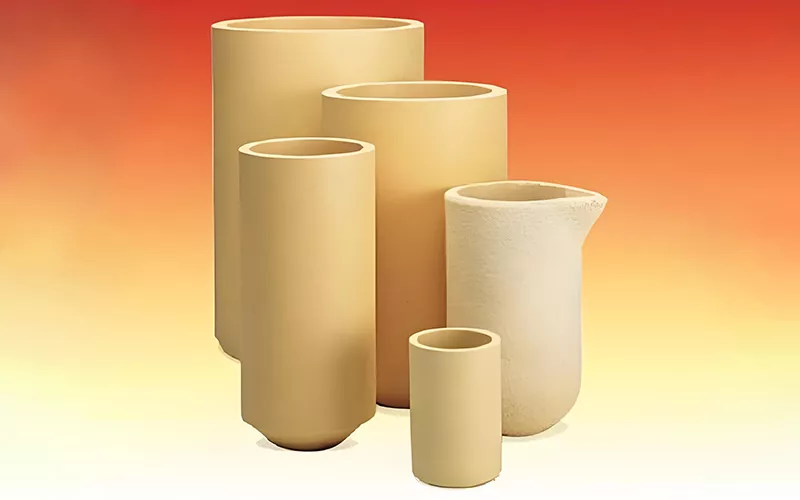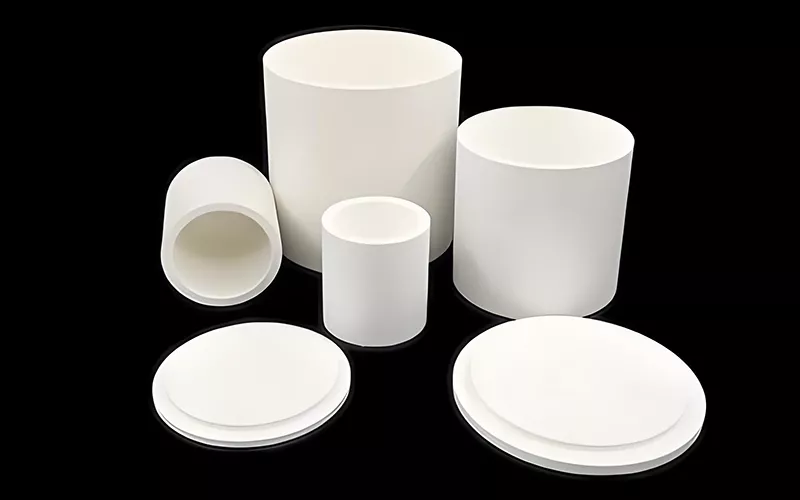Ceramic crucibles are containers with high melting points and high temperature resistance. They combine chemical stability with a low coefficient of thermal expansion, making them essential tools for extremely high-temperature applications in laboratories, metallurgy, semiconductor manufacturing, and other fields.
Ceramic crucibles are primarily made from advanced ceramics such as nhôm oxit, bo nitrua, Và oxit zirconi. In this article, we’ll explore ceramic crucible material selection, key characteristics, and service life to help you select the most suitable crucible for your high-temperature application.

Vật liệu của nồi nấu gốm là gì?
Nồi nấu nhôm
Nồi nung gốm alumina are primarily made of 99.7% pure aluminum oxide. Did you know? During the production process, many manufacturers, such as GORGEOUS, add small amounts of magnesium oxide (MgO) and silicon dioxide (SiO2) to impart superior physical and chemical properties to the crucibles.
Key Features: High-Temperature Resistance - Alumina crucibles can withstand temperatures of approximately 1700°C in a redox atmosphere. While offering superior performance, alumina crucibles are also price-competitive, making them the preferred material for many manufacturers.
Applications: Alumina crucibles are primarily used in laboratory and industrial metallurgy, heating, and chemical reactions.
Advantages: Alumina crucibles are one of the most economical ceramic crucibles on the market. Alumina’s high melting point and low thermal expansion coefficient make them resistant to cracking. They are ideal reaction vessels for weakly alkaline substances.
Limitations: Strongly corrosive substances, such as the strong base sodium hydroxide (NaOH), can severely damage alumina crucibles. For these materials, GORGEOUS recommends using a crucible material with strong corrosion resistance instead of alumina crucible.
Zirconia Crucible
Zirconia crucibles are primarily made of high-purity zirconium oxide. Their exceptionally high temperature resistance and chemical stability make them ideal for extremely high-temperature melting processes.
Key Features: Zirconia crucibles boast robust high-temperature resistance, capable of withstanding temperatures up to 2000°C, making them ideal for melting precious metals such as platinum (Pt) and palladium (Pd).
Zirconium oxide also possesses excellent chemical resistance, maintaining a stable structure even in harsh environments with strong acids and alkalis, making it an ideal crucible material for processes prone to corrosion.
Applications: Zirconia crucibles are primarily used in precious metal melting and certain processes involving high-melting-point materials.
Chén nung bằng nhôm Zirconia tôi luyện (Chén nung ZTA)
Zirconia-toughened alumina crucibles (ZTA) are primarily made of 90% alumina and 10% zirconia. This ceramic material combines the advantages of both alumina and zirconia, offering excellent high-temperature resistance and high toughness.
Các tính năng chính:
High Toughness - The addition of zirconia significantly improves the crucible’s crack and wear resistance, reducing damage caused by high temperatures and mechanical shock.
High-Temperature Resistance - ZTA crucibles can withstand temperatures up to 1700°C and operate stably in high-temperature environments.
Thermal Shock Resistance - Compared to pure alumina crucibles, ZTA crucibles offer higher thermal shock resistance, are more stable under severe temperature fluctuations, and are less prone to cracking.
Applications: These crucibles are primarily used in processes requiring high mechanical strength and high-temperature stability.
Nồi nung Boron Nitride (Nồi nung PBN)
Boron nitride crucibles are specially designed for use at extremely high temperatures. Their primary component is pyrolytic boron nitride.
Các tính năng chính:
High-Temperature Resistance - Boron nitride crucibles offer exceptional high-temperature resistance. In a protective atmosphere, they can reach temperatures of up to 2100°C and remain stable. They will not melt or react chemically with the substrate at extremely high temperatures.
Thermal Conductivity - Boron nitride crucibles have excellent thermal conductivity, allowing them to quickly dissipate heat, effectively preventing localized overheating, thermal stress, and thermal damage.
Low Thermal Expansion Coefficient - Boron nitride has a low thermal expansion coefficient, effectively reducing the risk of crucible cracking in high-temperature processes requiring rapid cooling or heating.
Applications: Boron nitride crucibles are primarily used in high-temperature processes such as semiconductor manufacturing and metal smelting. In the semiconductor industry, they are often used in chemical vapor deposition (CVD), crystal growth, and high-temperature evaporation.
Vật liệu gốm khác
Ngoài các vật liệu gốm thông dụng đã đề cập ở trên, còn có các vật liệu nồi nấu kim loại chất lượng cao như magie oxit và berili oxit. Tất cả đều có hiệu suất chịu nhiệt độ cao tuyệt vời và là vật liệu thiết yếu cho nhiều nhà máy luyện kim và phòng thí nghiệm.
Làm thế nào để đảm bảo tuổi thọ của lò nung?
If you want your crucible to have better performance and service life, you’d better do the following:
Kho:
Tốt nhất nên bảo quản chén nung đã qua sử dụng ở nơi khô ráo, sạch sẽ để tránh bị ẩm và nhiễm bẩn. Tránh bảo quản chén nung gần hóa chất hoặc ở những nơi có độ ẩm cao.
Vận hành:
Bạn nên sử dụng các công cụ phù hợp để vận hành nồi nấu, tránh tiếp xúc trực tiếp bằng tay và kiểm tra xem có vết nứt hoặc hư hỏng nào sau khi sử dụng không.
Vệ sinh:
Bạn nên vệ sinh nồi nấu kỹ lưỡng sau mỗi lần sử dụng. Cần loại bỏ hết cặn bẩn và cẩn thận để nồi nguội hẳn trước khi vệ sinh để tránh sốc nhiệt và nứt vỡ.
Câu hỏi thường gặp
1. Lò nung là gì?
Nồi nấu kim loại là vật chứa được thiết kế để sử dụng ở nhiệt độ cực cao, chủ yếu dùng để nấu chảy kim loại và phản ứng hóa học.
2. Nhiệt độ nóng chảy của nồi nấu bằng gốm là bao nhiêu?
Nhiệt độ nóng chảy của nồi nấu gốm phụ thuộc chủ yếu vào vật liệu được sử dụng. Ví dụ, nồi nấu nhôm có thể chịu được nhiệt độ từ 1650°C đến 1700°C, trong khi nồi nấu zirconia có thể chịu được nhiệt độ lên đến 2000°C.
3. Công dụng của nồi nấu gốm trong hóa học là gì?
Nồi nung gốm thường được sử dụng để nấu chảy kim loại ở nhiệt độ cao, làm vật chứa phản ứng hóa học, vật chứa xử lý vật liệu, v.v.
4. Chức năng của nồi nấu gốm là gì?
Nồi nung gốm chủ yếu được sử dụng cho các ứng dụng gia nhiệt ở nhiệt độ cao, nấu chảy hoặc tinh chế vật liệu, v.v. Nó cũng có thể hoạt động như một vật chứa cho một số phản ứng hóa học.
5. Tính chất vật liệu của nồi nấu gốm là gì?
Vật liệu gốm có đặc điểm là điểm nóng chảy cao, hệ số giãn nở nhiệt thấp, độ ổn định nhiệt tốt và khả năng chống ăn mòn hóa học.
6. Có thể sử dụng nồi nấu gốm để nấu chảy các chất kiềm mạnh không?
Điều này chủ yếu phụ thuộc vào vật liệu của nồi nấu. Nhìn chung, chúng tôi không khuyến nghị sử dụng nồi nấu nhôm để nấu chảy các chất kiềm mạnh như natri hydroxit (NaOH) và natri peroxit (Na₂O₂), vì những chất này có thể ăn mòn nồi nấu.
7. Sự khác biệt giữa nồi nấu sứ và nồi nấu gốm là gì?
Chén sứ thường dùng để chỉ loại chén nung làm bằng vật liệu sứ. Chén sứ có hiệu suất cao hơn chén sứ thông thường, chịu được nhiệt độ cao hơn và có tính chất cơ học tốt hơn.
8. Làm thế nào để đun nóng một chiếc nồi gốm?
Khi nung chén nung bằng gốm, cần lựa chọn phương pháp nung phù hợp với đặc tính của vật liệu. Cần lưu ý rằng trong quá trình nung, tránh làm nguội hoặc gia nhiệt đột ngột, vì có thể làm nứt chén nung.
9. Phương pháp bảo dưỡng nồi nung gốm là gì?
Sau khi sử dụng nồi nấu kim loại, bạn nên vệ sinh nồi thật sạch để loại bỏ cặn bẩn, sau đó dùng dung dịch tẩy rửa phù hợp để vệ sinh, cuối cùng rửa sạch bằng nước sạch và lau khô để sử dụng cho lần sau.
Phần kết luận
Ceramic crucibles are indispensable tools in modern chemistry and metallurgy. Capable of operating in extreme temperatures and harsh chemical environments, they play a key role in a wide range of scientific and industrial applications. GORGEOUS, a leading international supplier of advanced ceramics, offers custom-made ceramic crucibles in a variety of materials. Thank you for reading this article, and we hope you find it helpful.